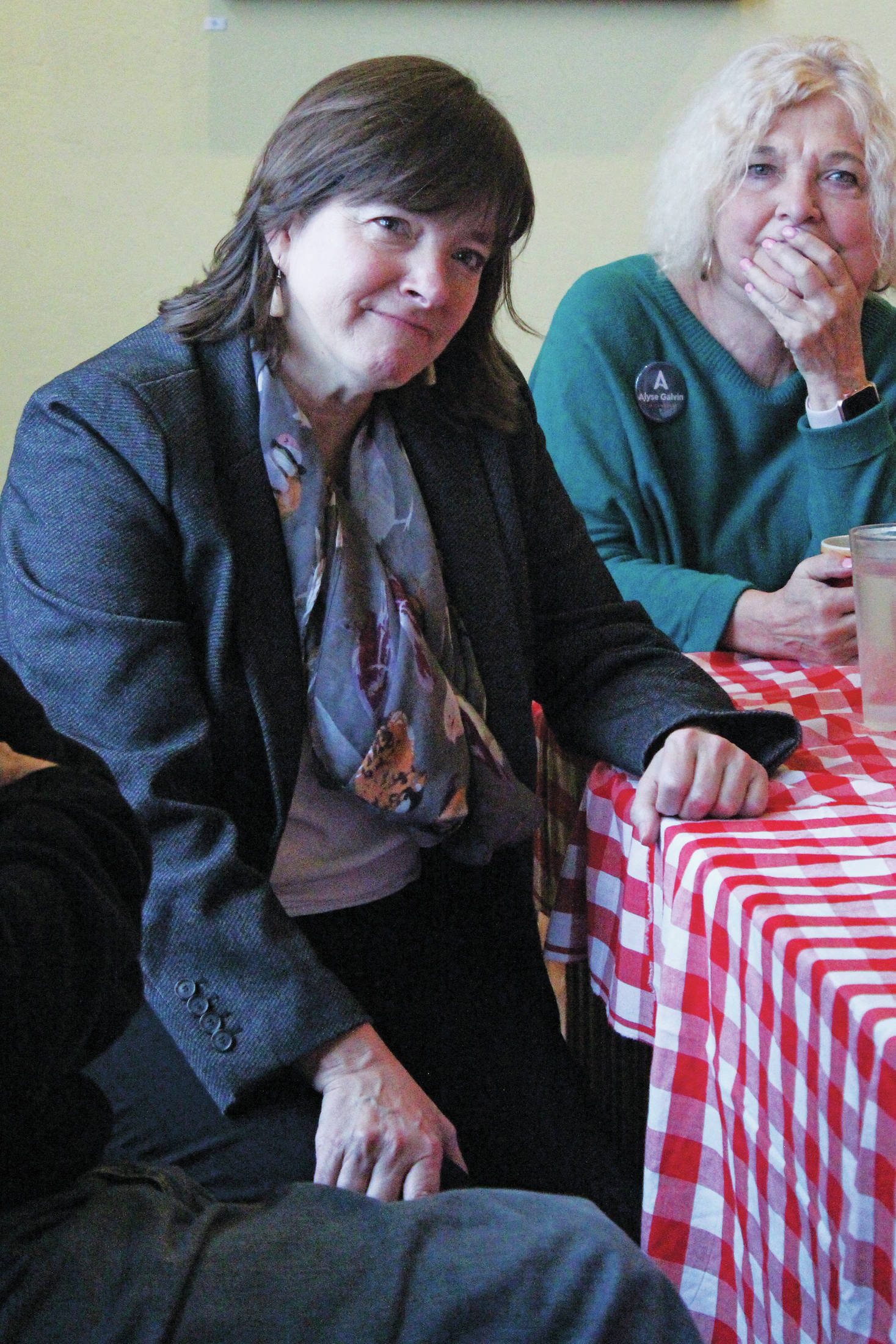After making a respectable run to unseat Alaska’s sole U.S. Representative, Don Young, in 2018, Anchorage’s Alyse Galvin is back at it for the 2020 election.
Galvin, who won the Democratic primary in 2018 before losing to Young in the general election running as an Independent, is already making the rounds visiting Alaska communities during her most recent campaign to represent the state in Washington, D.C.
Galvin was allowed to run in the Democratic primary after a Supreme Court decision. She then earned almost 47% of the vote in the general. Young has filled Alaska’s seat in the U.S. House of Representatives since 1973 and is the longest-serving Republican House member.
Galvin met with a handful of interested Homer area residents on Sunday afternoon at K-Bay Caffe. Before she spoke about the campaign, she went around the room and asked attendees what had brought them there, or what their main concerns were. Overwhelmingly, the answer was climate change and a concern that not enough is being done at the federal level to address it.
“We’re right on the edge, if not over the edge,” as one meet and greet attendee put it.
Others in attendance said they are concerned about the state of education, and still others cited heath care as a major issue of importance to them.
Galvin is once again running as an Independent. She’s also said she’s not accepting funding or campaign contributions from Political Action Committees that are corporately sponsored.
Speaking about what motivated her to run for Congress the first time around, Galvin explained her start with public service and her work with Great Alaska Schools, a pro-public education coalition group for which she was an advocate. It was while advocating for education in Washington, D.C., that Galvin said she realized things weren’t going to get accomplished without some deeper, systemic changes from within.
“I think most people want to know, how is thing going to change me and my pocketbook, or what’s happening in my home at my kitchen table,” Galvin said of Alaska voters. “It really isn’t too far different than others in other communities in Alaska. People want to take care of their own. They want to make sure that they’re in a job where they can come home and spend time with their family or their elders, and know that they’re taken care of. It’s the basics.”
Galvin said one thing that’s missing in Alaska is wage growth in jobs. She also pointed to the fact that a good portion of Alaska jobs are held by people who do not live here.
“So it’s time to make sure that we have someone in office who’s going to support (and) invest in cradle to career education so that our next generation, our kids, have a positive vision for them staying here,” she said.
Part of that equation of providing quality jobs for Alaskans is health care, Galvin said.
“We know that that’s strangling our small businesses,” she said. “Even public sector jobs. The reason we see teacher crises … it’s all about how much health care costs are rising unpredictably.”
These are all issues Galvin could effect at the federal level should she be elected, she said. Galvin acknowledged the teacher strike that nearly happened in the Kenai Peninsula Borough School District earlier this year. Contract negotiations were drawn out and tensions rose, in chief due to a sticking point over the cost of the health care plan for district teachers and staff. Galvin said there are a number of ways to address health care at the federal level, like reducing the price of pharmaceutical drugs.
A few people at Sunday’s meet and greet brought up resource extraction issues like the potential Pebble Mine Project proposed in Bristol Bay. Its watershed supports the largest salmon fishery in the world.
“I think that any kind of resource development needs to have important, sensible decisions around science-based decision-making,” she said. “I support a good process that listens to locals, that listens to scientists.”
Alaska is a resource state, but Galvin noted it’s important to balance taking care of the state’s natural resources that are extracted from the ground with taking care of its renewable natural resources, like those that come from Alaska’s waters.
“A great example of that is Pebble, where we see a huge mine potentially coming into play next to the largest fish run in the world of salmon,” she said. “And so that takes, again, a sensible, balanced decision-maker, and I am uniquely positioned as an Independent to represent that — to represent all Alaskans by listening to them first.”
A few local government representatives were present at Sunday’s meet and greet, including Homer City Council member Caroline Venuti, who spoke of concern for the state of education, and Kenai Peninsula Borough Assembly President Kelly Cooper.
Cooper is running in the 2020 election for Alaska’s District 31 House of Representatives seat currently held by Rep. Sarah Vance (R-Homer).
“Many of the issues that she’s (Galvin) speaking about are things that we have at the borough and at the state level,” Cooper said. “And the hyperpartisanship is what’s frustrating to me the most. We don’t have access because they’re so busy following their party lines and dealing with what their committee has determined as a priority as opposed to what all of us residents are saying.”
A better plan for health care is No. 1 on Cooper’s list for the state. She’s also a long time advocate for education as well.
“I’m ready for a new voice and someone that’s an independent thinker, and I think she’s the one,” Cooper said.
Homer resident John Whittier said accountability in politics is a major reason for his supporting Galvin.
“I think the most important thing is truth telling. Telling the truth, which I think has been lost,” he said. “So whether it’s climate change or political corruption, that’s what I would like to see from my representative.”
Reach Megan Pacer at mpacer@homernews.com.

